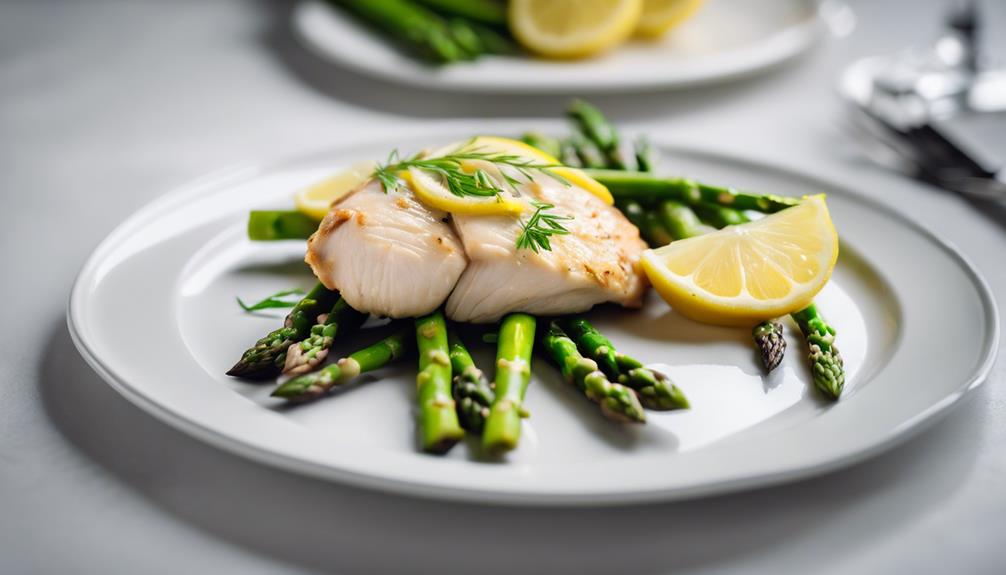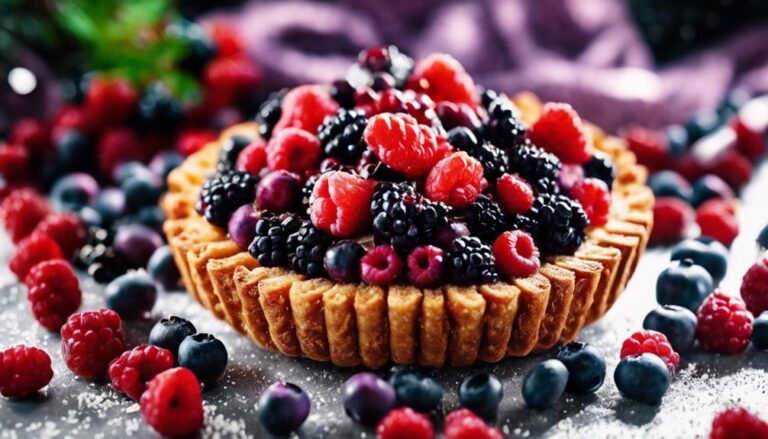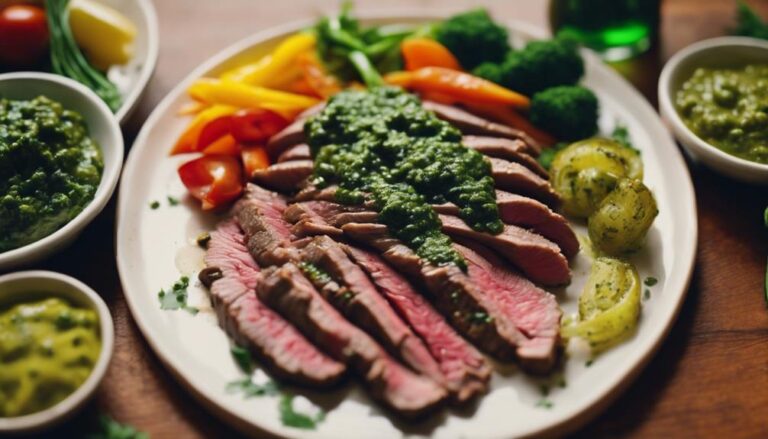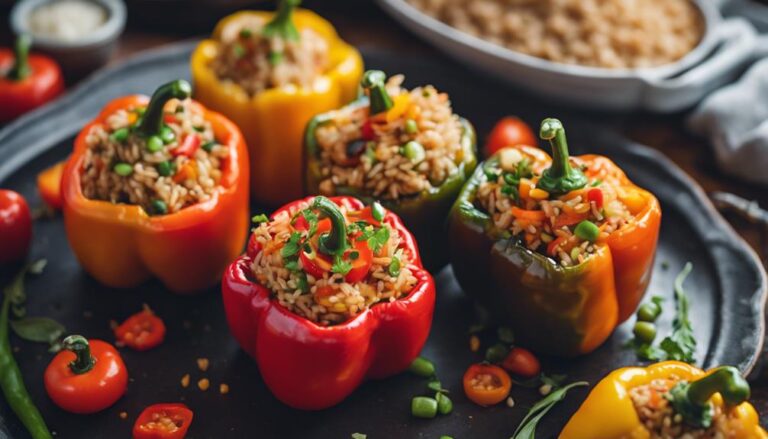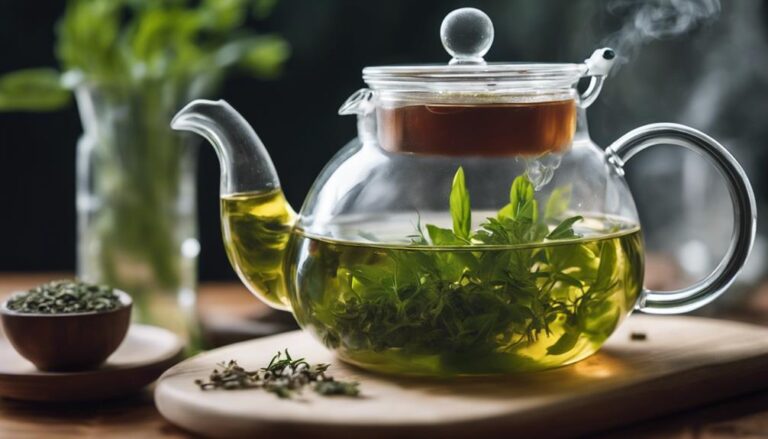Sous Vide Garlic-Lemon Chicken With Asparagus
Indulge in a culinary masterpiece: Sous Vide Garlic-Lemon Chicken with perfectly cooked asparagus. Enjoy the zesty blend of flavors and textures that will tantalize your palate. The precise sous vide technique guarantees moist, succulent chicken infused with lemon, garlic, and rosemary. Discover the harmony of tender asparagus cooked to perfection. Impress your guests with this restaurant-quality dish that promises a memorable dining experience. Take your taste buds on a journey with this exquisite combination. Learn more about creating this dish that will elevate your culinary skills and leave a lasting impression.
What You Will Learn Here
- Infuse chicken with lemon, garlic, and rosemary flavors for a zesty taste.
- Sous vide method ensures moist, succulent chicken.
- Perfectly cook asparagus using precise sous vide techniques.
- Elevate home cooking with restaurant-quality results.
- Impress guests with a harmonious blend of flavors and textures.
Asparagus' Historical Cultivation

Asparagus holds a rich historical legacy, cultivated for millennia across ancient civilizations like Egypt and Greece. Its journey to the Americas by European settlers in the 17th century marked a significant expansion of its culinary presence.
The Romans' medicinal beliefs and aphrodisiac associations with asparagus reflect the deep-rooted cultural significance of this versatile vegetable.
Cultivation History Overview
With a history spanning over 2,000 years, the cultivation of this perennial vegetable has captivated civilizations for its medicinal attributes and delicate taste. The ancient Greeks and Romans cherished asparagus for its unique properties, recognizing it not only as a culinary delight but also for its potential health benefits. Asparagus became a symbol of prosperity and sophistication, often reserved for the elite classes due to its labor-intensive cultivation process. The Middle Ages witnessed the spread of asparagus cultivation throughout Europe, leading to the development of diverse varieties across different regions. This vegetable's ability to yield spears for up to two decades once established made it a sustainable choice for farmers, ensuring a continuous harvest cycle. Below is a table highlighting key points about the historical cultivation of asparagus:
| Cultivation History Overview |
|---|
| Spanning Over 2,000 Years |
| Prized by Ancient Greeks and Romans |
| Spread Throughout Europe in the Middle Ages |
Asparagus Growth Conditions
Certainly, the historical cultivation of asparagus highlights the careful attention to ideal growth conditions for maximum yields and quality. As a cool-season crop, asparagus thrives in well-drained, sandy soils under full sun exposure, essential for its peak growth.
The tender shoots, a culinary delight, are harvested when they reach 6-8 inches in length, offering a delectable addition to dishes like the Sous Vide Garlic-Lemon Chicken With Asparagus. Through centuries of cultivation, different varieties have emerged worldwide, each contributing unique flavors and colors to culinary creations.
The cultivation of asparagus reflects a dedication to providing the best conditions for the plant to flourish, ensuring a bountiful harvest for dishes like the succulent sous vide chicken paired with zesty lemon-infused asparagus.
Historical Culinary Uses
Exploring the historical culinary uses of asparagus reveals a rich tapestry of traditions and flavors that have stood the test of time, offering insights into the evolution of gastronomy and cultural significance.
Asparagus, cultivated for over 2,000 years, was cherished by ancient Greeks and Romans for both its medicinal properties and gastronomic appeal. Ancient Egyptians depicted asparagus in their artwork, highlighting its luxury status.
Throughout the 16th century, asparagus gained popularity across Europe, becoming a culinary staple in various cuisines. The vegetable's association with springtime symbolizes renewal and essential in many cultures.
Its delicate flavor and unique texture have made asparagus a prized ingredient in historical dishes, showcasing its enduring value in the culinary world.
Asparagus Selection Tips
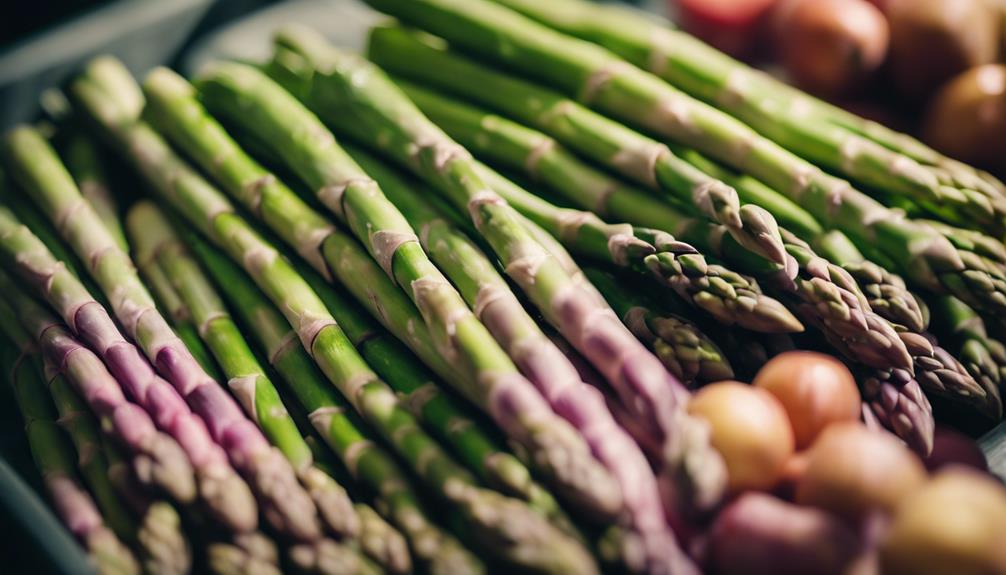
For the best quality asparagus selection, seek out fresh stalks with tightly closed tips. When picking asparagus, take into account your preference for the stalks' diameter as it can impact the texture and cooking time.
The color of asparagus can also vary, with choices like green, purple, and white, adding visual appeal and different flavors to your dish. Opting for asparagus, which is part of the Clean 15 list, guarantees you're choosing a produce item with lower pesticide residues, promoting a healthier choice for your meal.
To maintain the freshness of your asparagus, store it properly by trimming the ends and placing them in water in the refrigerator. This simple step helps to preserve the asparagus's crispness and flavor until you're ready to use it.
Sous Vide Asparagus Varieties
When preparing sous vide asparagus, consider the variety of colors available, such as green, purple, or white, to add visual appeal to your dish.
Experiment with different stalk diameters to find what suits your recipes best, as thinner asparagus might cook faster than thicker ones.
Enhance the flavor of your sous vide asparagus by seasoning it with salt, pepper, and lemon zest for a delightful culinary experience.
Sous Vide Asparagus Varieties
For a vibrant array of color choices in your sous vide cooking, consider exploring various varieties of asparagus such as green, purple, and white to elevate the visual appeal of your dishes.
When selecting asparagus, opt for those with tightly closed tips for the best freshness and tenderness. Asparagus, known for being part of the Clean 15, is a safe and healthy choice for consumption.
Personal preference plays a key role in cooking asparagus, allowing you to choose the stalk diameter that suits your taste and recipe requirements.
Proper storage techniques are essential to maintain the freshness and flavor of asparagus, ensuring you get the most out of this delicious and versatile vegetable.
- Choose asparagus with tightly closed tips
- Asparagus is part of the Clean 15
- Personal preference in stalk diameter
- Proper storage methods
- Colorful varieties: green, purple, and white
Sous Vide Asparagus Varieties
Explore the vibrant array of color choices in your sous vide cooking by experimenting with different varieties of asparagus such as green, purple, and white to elevate the visual appeal of your dishes. When using asparagus in a sous vide water bath, the choice of variety can impact not only the presentation but also the taste and texture of the final dish. Here are some points to explore when selecting asparagus varieties:
- Green asparagus is the most common type, offering a robust flavor profile.
- Purple asparagus has a slightly sweeter taste and a vibrant hue that can add a pop of color to your plate.
- White asparagus is milder in flavor and is grown underground to prevent chlorophyll development, resulting in its pale color.
Experimenting with different varieties can bring a delightful twist to your sous vide dishes. Season your asparagus with a pinch of salt, pepper, and lemon zest before placing it in the water bath for a burst of fresh citrus flavor.
Lemon Butter Asparagus Recipe
Enhance your culinary repertoire with the vibrant and flavorful Lemon Butter Asparagus recipe, a perfect accompaniment to the succulent sous vide garlic-lemon chicken.
- Fresh Asparagus: Select firm, bright green asparagus spears for the best flavor and texture.
- Lemon Zest: Grate fresh lemon zest over the seasoned asparagus to add a zesty kick.
- Sous Vide Cooking: Seal the asparagus with olive oil, salt, and pepper in a vacuum bag for precise cooking.
- Crisp-Tender Texture: Cooking asparagus sous vide preserves its crunch while infusing it with rich flavors.
- Elegant Side Dish: Lemon butter asparagus elevates any meal with its vibrant colors and citrusy notes, making it a versatile side dish.
Sous Vide Timing Tips
When cooking asparagus sous vide, timing is essential for achieving the perfect texture and flavor. Precision in cooking times guarantees that the asparagus is neither overcooked nor undercooked, resulting in a delightful dining experience.
Mastering sous vide techniques like timing will elevate your culinary skills to new heights.
Timing for Asparagus
For ideal sous vide asparagus outcomes, maintain a cooking temperature of 180°F to guarantee ideal texture and flavor in every stalk. Cooking asparagus sous vide requires precise timing to achieve the perfect balance between tenderness and crispness. Depending on the thickness of the asparagus stalks, cooking times may vary, typically ranging from 10 to 30 minutes.
Thicker asparagus will need longer cooking times to assure even cooking throughout. Remember to trim the asparagus ends before seasoning with salt, pepper, and lemon zest for enhanced taste. Properly seal the seasoned asparagus using a vacuum sealer or the water displacement method to assure even cooking.
Precision in Cooking
To guarantee precise and consistent results when cooking sous vide, pay careful attention to the recommended temperatures and cooking times for each type of protein.
When preparing chicken breasts, make sure boneless ones cook at 145°F for 1 hour, while bone-in breasts require 2 hours at the same temperature. Remember, chicken can remain in the sous vide bath for up to 4 hours without overcooking, but avoid surpassing this time to maintain texture.
For a softer texture, set the temperature at 145°F and for a firmer texture, opt for 155°F when cooking sous vide chicken breasts. To achieve the best results, set your sous vide machine to 165°F.
If you don't have a sous vide machine, follow alternative sous vide methods to ensure precise cooking temperatures.
Sous Vide Techniques
Pay close attention to the sous vide timing tips to ensure perfectly cooked chicken with the desired texture and doneness.
When cooking chicken breasts sous vide, the temperature is essential. For a softer texture, set your sous vide machine to 145°F, while 155°F will result in a firmer texture.
Boneless chicken breasts typically require 1 hour of cooking time, while bone-in breasts might need up to 2 hours. Remember, you can safely leave the chicken in the sous vide machine for up to 4 hours without overcooking, but avoid going beyond this to maintain the ideal texture.
If your machine allows, setting it to 165°F can also be an option for cooking chicken breasts. Proper temperature control is vital for achieving the perfect texture when cooking chicken sous vide.
Final Thoughts
Reflecting on the culinary journey of preparing Sous Vide Garlic-Lemon Chicken with Asparagus reveals a harmonious blend of flavors and textures that elevate the dining experience to a new level of sophistication. The union of tender chicken, infused with zesty lemon, pungent garlic, and aromatic rosemary, creates a symphony of tastes that dance on your palate with each bite. The sous vide method guarantees that every morsel of chicken remains moist and succulent, bursting with the essence of the carefully curated flavors. The asparagus, cooked to perfection using the same precise technique, emerges as a vibrant and tender side dish that complements the chicken beautifully.
This dish isn't just a meal; it's an experience. Perfect for any occasion, from intimate family dinners to grand celebrations, the Sous Vide Garlic-Lemon Chicken with Asparagus promises to impress and delight your guests. The meticulous attention to detail in the sous vide cooking process assures consistent results, allowing you to serve a restaurant-quality dish from the comfort of your home. Let this exquisite combination of chicken and asparagus elevate your culinary repertoire and leave a lasting impression on all who've the privilege of savoring it.
Frequently Asked Questions
Can You Sous Vide Chicken and Vegetables Together?
Yes, you can sous vide chicken and vegetables together. It's convenient for meal prep, infusing flavors and controlling textures. Just make sure separate bags to avoid mixing tastes. Adjust cooking times based on thickness for perfectly cooked dishes.
Why Is My Sous Vide Chicken Rubbery?
To avoid rubbery chicken in sous vide, follow these tips for tender meat: cook at proper temps, use flavorful marinades, and don't overcook. Troubleshoot by checking internal temp with a thermometer. Enjoy delicious, juicy chicken!
What Is the Best Temperature to Sous Vide Chicken?
When sous vide cooking chicken, the best temperature range to achieve the desired tenderness is typically 145°F to 155°F. This range allows for precise control over the chicken's texture, ensuring a delicious outcome with sous vide techniques.
Is It Safe to Sous Vide Chicken at 145 Degrees?
Yes, it's safe to cook chicken sous vide at 145 degrees Fahrenheit. By following temperature guidelines and employing precise cooking techniques, you can guarantee pasteurization and address food safety concerns effectively while enjoying tender, flavorful chicken.
Conclusion
Experience the tender and flavorful sous vide garlic-lemon chicken with perfectly cooked asparagus. The sous vide technique guarantees that every bite is juicy and infused with the delightful combination of garlic and lemon.
Asparagus, cooked to perfection, adds a crisp and fresh element to the dish. This meal is a genuine culinary delight that will leave your taste buds satisfied and longing for more.
Enjoy the exquisite flavors and textures of this delightful dish!
